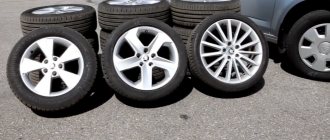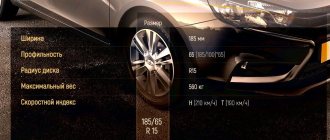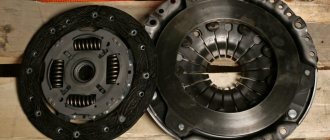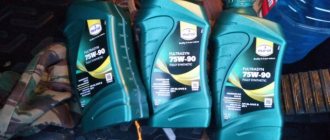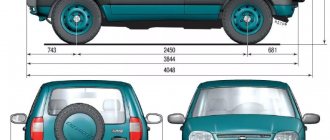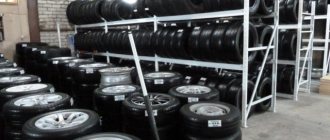Main characteristics of Lada Vesta car wheels
For the Lada Vesta, the manufacturer has provided the following tire sizes:
| Body type | Tires with speed and maximum weight designations |
| Sedan | 185/65 R15 88Н 195/55 R16 91Н |
| Station wagon | 185/65 R15 88Н 195/55 R16 91Н |
| Cross | 205/50 R17 89V 205/50 R17 93W |
| Sport | 205/50 R17 (93/89, W/V) |
As can be seen from the table, the tire size on Vesta depends on the body type. The sedan and station wagon use 15 and 16-inch tires, while Cross and Sport cars boast “impressive” 17-inch wheels.
The tire size requires the use of suitable wheels. Information on the correspondence of these sizes can be gleaned from the following table:
| Body type | Discs | ||||
| Central hole diameter, mm | Circumference diameter of mounting holes, mm | Number of mounting holes (pcs) | Width (inches) | Disc offset (mm) | |
| Sedan | 60.1 | 100 | 4 | 6J | 50 |
| Station wagon | 60.1 | 100 | 4 | 6J | 50 |
| Cross | 60.1 | 100 | 4 | 61/2J | 43 |
| Sport | 60.1 | 100 | 5 | 61/2J | 43 |
The indicated sizes of tires and wheels are installed on Vesta cars from the factory, and in order for the car to demonstrate its optimal performance characteristics, owners are recommended to use exactly these sizes.
Related link:
What you need to know about the new manual transmission on the Lada Vesta
Alloy wheels and their parameters - everything you need to know
When purchasing 15, 16 or 17 inch wheels for your car, don’t expect them to last forever - they won’t. In time, the question of replacement will arise. Russian roads force even expensive wheels to break quickly. Some drivers are not satisfied with the parameters of the wheels or tires, so they change them.
If the time for replacement has come, many parameters must be taken into account. These are wheel size, rim type, rim offset (ET), wheel bolt pattern, diameter and other parameters. Products with the following technical data are suitable:
- casting with wheel size 175/70/R16 or 205/60/R16;
- alloy wheels 175/55/R17 and 195/50/R;
- for the Lada Vesta SV Cross station wagon, 18-inch wheels are needed;
- tires are used exclusively on 16 and 17 inches.
AvtoVAZ uses a number of wheels produced by K&K. If you take them, drilling, bolt patterns and other parameters will converge. A good option would be to install r16 and 17 Phoenix wheels.
The plant recommends choosing narrow winter tires for the Lada Vesta. This is necessary to increase stability when driving on slippery roads in sub-zero conditions.
Before purchasing wheels, pay attention to the bolt pattern. On the Lada Vesta it has changed somewhat; not all wheels will be compatible with it. The rims are secured with 4 bolts, the diameter of the mounting holes is 100 mm. The wheels of Korean cars have similar characteristics.
We do not recommend installing wheels with a significantly larger diameter. This will make driving less comfortable. It will be less resistant to driving on uneven roads.
Is it possible to install tires of other sizes on the Lada Vesta?
Despite the rather strict instructions of the manufacturer, many drivers decide to replace the standard Lada Vesta wheels and tires with taller or wider tires. Is it possible to do this?
Depending on driving style and operating conditions, changing dimensions is allowed, but only within certain limits. In addition to those indicated by the manufacturer, the following tire and wheel sizes can be installed on Vesta:
| Body type | Tire sizes | Discs | ||||
| Central hole diameter, mm | Circumference diameter of mounting holes, mm | Number of mounting holes, pcs | Rim Width (inches) | Disc offset(mm) | ||
| Sedan and Station Wagon | 185/65 R15 88T, H 195/55 R16 87, 91T, H | 60.1 | 100 | 4 | 5J, 51/2J, 6J, 61/2J | 50 |
| Cross and Sport | 205/50 R17 89H,V 205/50 R17 93W | 60.1 | 100 | 4 | 51/2J, 6J, 61/2J | 43 |
When making such changes, the driver needs to take the choice of tires and wheels seriously, and act in strict accordance with the selection rules. Otherwise, the stability and controllability of the vehicle may be affected, as well as fuel consumption while driving may increase.
Important points
The choice is not an easy matter, there are many manufacturers to suit every taste and budget, studded, Velcro. Different sizes of tires and wheels. Let's try to understand a complex topic using a specific example. I’ll show you which tires I chose, the tire size – width, height, wheel size. I’ll tell you why I decided to choose these particular tires, what motivated me and how much it costs.
I do not advertise any products or collaborate with stores. I bought the wheels with my own money. All advice is personal, you may not agree with it. Please express your questions and opinions in the comments.
Decoding Lada Vesta tire sizes
The tire sizes given in the tables are encrypted in the form of numbers and letters, which do not mean anything to the uninitiated person. In order to understand what parameters a tire has, you need to be able to read their markings correctly.
For example, let's take the standard size for Lada Vesta Cross 205/50 R17 89V. You can decrypt it this way:
- The first number indicates the width of the tire in millimeters. In our case it is 205 mm.
- The second number, which is written separated by a slash, indicates the ratio of the tire width to its height as a percentage. If this value is 50, then the tire width will be 102.5 mm.
- The letter R does not denote the radius, as most drivers believe, but the radial type of tire. Most modern products use this type of internal structure.
- After the letter R, the manufacturer indicates the rim diameter (also known as the inner diameter of the tire, measured in inches). In our example it is 17 inches.
- The next number indicates the maximum load on the wheel. The index, which in our case is 89, means that the maximum load should not exceed 580 kg. Data on this can be seen in the table below:
Related link:
Blizzak winter tires.
| Meaning | Load, kg | Meaning | Load, kg | Meaning | Load, kg | Meaning | Load, kg | Meaning | Load, kg |
| 62 | 265 | 75 | 387 | 88 | 560 | 101 | 825 | 114 | 1180 |
| 63 | 272 | 76 | 400 | 89 | 580 | 102 | 850 | 115 | 1215 |
| 64 | 280 | 77 | 412 | 90 | 600 | 103 | 875 | 116 | 1250 |
| 65 | 290 | 78 | 425 | 91 | 615 | 104 | 900 | 117 | 1285 |
| 66 | 300 | 79 | 437 | 92 | 630 | 105 | 925 | 118 | 1320 |
| 67 | 307 | 80 | 450 | 93 | 650 | 106 | 950 | 119 | 1360 |
| 68 | 315 | 81 | 462 | 94 | 670 | 107 | 975 | 120 | 1400 |
| 69 | 325 | 82 | 475 | 95 | 690 | 108 | 1000 | 121 | 1450 |
| 70 | 335 | 83 | 478 | 96 | 710 | 109 | 1030 | 122 | 1500 |
| 71 | 345 | 84 | 500 | 97 | 730 | 110 | 1060 | 123 | 1550 |
| 72 | 355 | 85 | 515 | 98 | 750 | 111 | 1090 | 124 | 1600 |
| 73 | 365 | 86 | 530 | 99 | 775 | 112 | 1120 | 125 | 1650 |
| 74 | 375 | 87 | 545 | 100 | 800 | 113 | 1150 | 126 | 1700 |
- After the load index comes the speed indicator. You can also determine it using the table.
| Permissible speed (km/h) | Speed value |
| 120 | L |
| 130 | M |
| 140 | N |
| 150 | R |
| 160 | Q |
| 170 | R |
| 180 | S |
| 190 | T |
| 200 | U |
| 210 | N |
| 240 | V |
| 270 | W |
| 300 | Y |
| Exceeds 300 | Z |
In addition to this basic information, additional information is also indicated on the tires. For the average motorist, an important indicator will be the company and country of manufacture, as well as the seasonality of the tires. Tires intended for winter have a snowflake pictogram and the designation W or M+S (M&S, Mud + Snow). Summer tires are sometimes designated with a “sun” pattern, but do not have a letter designation.
Monitoring tire pressure Lada Vesta
An important condition for long and efficient operation of car tires is maintaining the required pressure in them. If this indicator is not controlled, the tires may wear out ahead of time, and the quality of driving will noticeably decrease.
Related link:
Winter radiator protection for Lada Vesta: review, recommendations, installation
The recommended tire pressure for the Lada Vesta in the Lada Vesta tires at partial load is:
| Tire size | Front wheel | Rear wheel |
| 195/55 R16 | 210/2,1 | 210/2,1 |
| 185/65 R15 | 210/2,1 | 210/2,1 |
When the vehicle is fully loaded, the tire pressure must correspond to the following values:
| Tire size | Front wheel | Rear wheel |
| 195/55 R16 | 200/2,0 | 220/2,2 |
| 185/65 R15 | 200/2,0 | 220/2,2 |
This information can also be obtained from the label located on the driver's side pillar, which can only be seen when the door is open.
Is the car out of warranty?
If you do not put something completely unusual on the car, then there will be no problems with the dealer. They sell and install wheels themselves, which do not always correspond to the dimensions of AvtoVAZ. If you were denied a warranty due to the size of the wheels, be sure to write and we will discuss the issue. So far I am not aware of such cases.
As a result, I ordered Michelin X Ice North 4 size 195/65 R15, they are a little more expensive than 185. I paid 4040 rubles for them. I bought the wheels from SCAD Samurai with an offset of 45 mm - 3590 rubles. Plus 600 rubles – tire fitting. Slightly exceeded my budget, spent a total of 31,120 rubles. The discs were packed in boxes, nothing was damaged.
The stove on the Lada Vesta does not warm the feet well - what to do
If you liked the publication, give it a thumbs up, subscribe to the channel, and write comments. What else would you like to know about Vesta? If you share this article on social networks, it will be very great for the development of the channel!
Which tires to choose for the Lada Vesta?
Car tire manufacturers offer a wide variety of tire options, with all sorts of functional features and costs. The wide variety of models makes choosing tires quite difficult, and Lada Vesta owners often do not know which tires are best suited for their car and how to make the right choice of tires.
When selecting tires, you should first of all pay attention to the conditions under which they will be used. For southern latitudes with mild winters, you can get by with all-season tires, while northern regions require the mandatory installation of winter tires. Summer tires become too hard in sub-zero temperatures and cannot provide sufficient traction.
One of the most important parameters is the tread pattern of car tires, the type of which determines the main characteristics of the tire. The tread of a passenger car can be symmetrical or asymmetrical, and also have directional or non-directional grooves on the working surface.
There are 4 tread pattern options:
- Symmetrical tread with non-directional pattern;
- Symmetrical tread with directional pattern;
- Asymmetrical tread with non-directional pattern;
- Asymmetrical tread with directional pattern.
Let's take a closer look at the features of each of them:
| Tread type | Peculiarities |
| Symmetrical omnidirectional | The simplest and most inexpensive tread option. It is suitable for any type of road surface, but is not intended for travel at high speeds. The disadvantage of this type is poor drainage of water from the contact patch. |
| Symmetrical directional | Ideal for high speeds. It removes water well from the surface and provides excellent vehicle control. Not suitable for off-road driving and is noisy. |
| Asymmetrical omnidirectional | The outer part of the tire is responsible for stability and maneuverability, and the inner part ensures good water drainage. Tires of this type are the most practical and popular option among car enthusiasts. Their disadvantage is their high cost and insufficient vibration absorption. |
| Asymmetrical directional | The rarest type of tire, which is practically never used. Its main disadvantage is that each wheel must be installed strictly in its place, and in order to change a tire on the road, you must have 4 spare wheels with you. |
Related link:
Camshaft sensor for Lada Vesta.
Choosing tires for different operating conditions
Winter becomes a real headache for car enthusiasts; some prefer not to use their cars during this period, while others have to buy winter tires. You cannot drive on summer tires in the cold season - their composition is not designed for low temperatures. Braking, starting to move, and driving become impossible.
Choosing winter tires
Large tires can be installed on Vesta, but for winter it is better to install smaller wheels. If R16 is used in summer, then R15 is recommended for winter. The tire width is also selected smaller. In winter, speed characteristics are not so important. Studded tires and so-called “Velcro” tires are available on the market. It is ideal for residents of large cities who rarely go off-road. Spikes are not needed on asphalt roads. For those who often travel on snowy, icy roads, they are definitely necessary.
Tread pattern selection
There are three types of drawing:
Tire tread pattern
- Symmetric. Both sides of the pattern are the same and have a wave or bridge shape. Equally effective on snow and ice. Loses its properties on snow porridge in the spring or after treatment with reagents.
- Directed. It is not afraid of snow, ice, and also does not lose its properties in slush. Not suitable for use on dry asphalt due to increased noise. The peculiarity of these tires is in the direction - they must be mounted strictly according to the direction of travel arrow, which is indicated on the outer side of the product with the inscription “Rotation”.
- Asymmetrical. In addition to all the advantages of the described figures, noise reduction and high speed characteristics are added. It is installed according to marks indicating the inside and outside with inscriptions on the sides - “Inside”/“Outside”. The only drawback is the high price.
To save money, you can use the directional option. If your budget allows, it is better to choose an asymmetrical pattern.
Selection by stud size
A regular thorn looks like a nail - this is the most common type. There are also other shapes - square, rectangle. At the same time, at speeds up to 60 km/h, the braking distance does not change in any way, and there is no point in paying more, because in winter it is unsafe to increase the speed. From popular brands you can choose the following:
- Nokian Hakkapeliitta 8 – is in the middle price range, the estimated cost is from 4 to 5 thousand rubles;
- Bridgestone Blizzak Spike-01 – from 3 thousand rubles;
- Yokohama Ice Guard F700Z – average price – 2 thousand rubles;
- Dunlop Ice Touch – average price – 2.7 thousand rubles;
- Michelin X-Ice North 3 – 3-3.5 thousand rubles;
- “Kama Euro” 519 and “Belshina” Bel-127 - up to 2 thousand rubles.
The choice is large, for high quality and brand you will have to pay a substantial amount. If your budget is limited, you can purchase domestically produced winter tires. They are cheaper, but this does not mean that their quality and efficiency are worse.
Choosing summer tires
Summer tires for cars are made from hard compounds, which is determined by temperature and speed operating conditions. These tires wear out more slowly and do not lose grip on hot asphalt. These wheels have a different tread pattern and depth from winter ones.
Tire size
Choose a size that matches the manufacturer's requirements. It is possible to use alternative options, but in this regard different points should be taken into account:
- If the outer diameter of the wheel turns out to be larger than the manufacturer allows, it will cling to the arch when driving over uneven surfaces and when turning.
- When installing tires with a large width, there will also be friction along the arches, which is unsafe and leads to rapid wear of the rubber.
- Installing tires with a low profile will make the suspension too stiff, which will lead to failure of the chassis components. But low-profile tires increase steering sensitivity, allowing you to better control the car when driving at high speeds. This is not the best option for driving on domestic roads.
- An excessively high profile reduces control efficiency; at high speed, there is a high risk of losing the tire from the rim, which will lead to an accident. Properly selected high-profile tires improve the smoothness of movement, easily absorb all potholes and bumps, and are able to preserve the life of the suspension.
Summer tires on the Lada Vesta should be wider (within reasonable limits), this increases the contact patch with the road surface and improves dynamic characteristics. But this will lead to increased fuel consumption and the risk of aquaplaning even at low speeds when driving through puddles. Based on this, we can conclude that when choosing the type of tires, many factors need to be taken into account. In most cases, it is advisable to stick to the size recommended by the manufacturer. For the average car driver in city mode, this is enough.
Tread selection
According to the type of pattern, there are symmetrical, asymmetrical and directional protectors. An inexpensive option is a standard tire with a non-directional pattern. It has average characteristics of controllability, comfort and aquaplaning prevention. In terms of price-quality ratio, it will be the best option for leisurely trips. If necessary, the tires can be placed on different sides.
Rubber with a directional pattern has better handling, comfort and prevents aquaplaning. One of the advantages of this pattern is the quick removal of water from the tread. They are installed in accordance with the direction of travel, so they cannot be mounted differently when rearranging the wheels between the right and left sides. Otherwise, control safety is sharply reduced.
Rubber with an asymmetric tread pattern is a universal option with equally good handling and comfort on various road surfaces. The outer part consists of larger and more rigid blocks, which improve cornering control. The tread pattern on the inside consists of smaller blocks and drains water more efficiently, increasing traction on wet asphalt. To ensure directional stability, there is a longitudinal stiffener rib in the middle. Such wheels can be moved from one side to the other. The only drawback is the high price compared to directional and non-directional tires.
Popular brands of summer tires for Lada Vesta include:
- TRIANGLE GROUP TR928 – cost does not exceed 2.5 thousand rubles;
- NOKIAN NORDMAN SX2 – from 3 thousand rubles;
- MICHELIN ENERGY XM2 – from 3.5 thousand rubles;
- YOKOHAMA GEOLANDAR SUV G055 – from 7 thousand rubles;
- HANKOOK VENTUS V12 EVO2 K12 – from 8 thousand rubles.
The most affordable option is Kama Euro and Belshina tires, the cost of which usually does not exceed 2 thousand rubles per tire.
Selection of all-season tires
The constant rise in prices for cars and related products forces car owners to look for ways to save money. One of its options is to buy universal tires. This type of tire is only suitable for countries where the climate is mild all year round. “All-season” vehicles are not suitable for the harsh winter months of the middle zone. When the temperature drops to 7 degrees, the elasticity of rubber with the “allseasons” index decreases, the braking distance increases and the risk of losing control increases. An all-season tire is a middle option between summer and winter, so you shouldn’t expect high performance from it.
“All-season tires” have a less frequent tread pattern compared to winter tires and are of medium softness. The side part has rounded shapes, dissected sipes, and a tread with deep recesses. For summer they show good grip qualities, but for snow and ice they are useless. You can identify such tires by the inscription “All Seasons”. It has no practical meaning - driving is allowed at temperatures not lower than -5 degrees. At lower temperatures the tire becomes too hard.
The advantage is that you don’t need to buy a set of winter and summer tires, which saves money. The issue of storing one of the sets is resolved, since the tires are always on the car. With the right choice, such tires can cope with snow (provided there is a mild winter).
“All-season” models have significantly more disadvantages. Use on ice and deep snow is ineffective and unsafe. At low temperatures, tires become tanned in the same way as summer tires, losing their grip and can cause an accident. Year-round use results in faster wear.
“All-season tires” cannot withstand high temperatures, become too soft, wear out faster and reduce control efficiency.
When buying such tires you need to adhere to some rules:
- Choose brands. There is no point in giving preference to domestic manufacturers because of lower prices. The quality in most cases corresponds to the price.
- Tread quality. Manufacturers produce tires for primary use in both summer and winter. The latter are more suitable for driving outside the city, as they do a good job of removing dirt and water. There is also a third type - mud tires. It has excellent traction and high cross-country ability, but when driving on asphalt they create a lot of noise at high speed.
When choosing, pay attention to the indices indicated on the bus. They must comply with the vehicle manufacturer's requirements. On the modern market there are several options that are most suitable for operation on the Lada Vesta:
- Pirelli Scorpion Verde Allseasons - average price about 10 thousand rubles;
- Yokohama Y534 – up to 8 thousand rubles;
- Cordiant off road – up to 5 thousand rubles.
For obvious reasons, domestic manufacturers were not included in this list.
Winter tires for Lada Vesta Cross. We select the best option
The Lada Vesta Cross is a Russian-made SUV, purchasing which the driver expects high cross-country ability and adaptability to difficult road conditions, especially in winter. And these characteristics largely depend on the correct selection of tires.
The recommended tires for the Lada Vesta are 205/50 R17, so we will consider this particular size. The very first parameter that is considered when selecting winter tires is the absence or presence of studs on the tread. Determining this parameter is quite simple, since it directly depends on the region in which the car is used. For harsh and especially snowy winters, studs are recommended, as they provide reliable grip on ice, and for milder winters, you can choose winter tires with a deep tread, the so-called “Velcro”, which is less noisy and maneuvers well in a slurry of ice and snow, which is formed during a thaw.
As for the tire manufacturer, the choice here directly depends on the financial capabilities and desires of the owner. Manufacturers such as Nokian, Bridgestone and Continental have proven themselves best. They are distinguished by consistently high quality rubber and a long service life. Of the more affordable options, many drivers prefer Pirelli or Matador, which are produced in Russia and belong to the middle price category.
Tires for lada vesta sw cross 2022 1.8ib/c
At the moment, there are 618 tire modifications for the Lada Vesta SW Cross on Mosavtoshina with an average rating of 4.45/5. Add your review.
Selecting tires and wheels for the Lada Vesta SW Cross 1.8i B/C 2021 allows you to reduce to a minimum the occurrence of various difficulties associated with the fact that many car owners often make mistakes when choosing such products on their own. In a significant proportion of cases, this is due to the failure to use a number of technical parameters. It is for this reason that installing a tire and wheel becomes very difficult and often impossible, and in addition, such changes in the vehicle’s configuration lead to increased load on the steering and many suspension components. The tire and wheel selection system of the Mosavtoshina online store contains a special database that contains various technical characteristics of almost all modern cars and trucks. To use this information to search for suitable options, the user simply needs to indicate the make, model, year of manufacture and modification of his own vehicle.
Rate the article!
Owner reviews about tires for Lada Vesta
| Positive | Negative |
| I bought the car new from the showroom. Winter tires were not included in the package, so as the season approached, I had to think about what tires to install for the winter. After much thought, I settled on the Yokohama F700Z model. Compared to domestic manufacturers, these tires are much more comfortable, softer and almost silent. I've been driving for the second month now, the studs are still in place. At the end of the season I will add a review. | My Vesta has Nokian Nordman 5. In terms of comfort and cross-country ability, they are not bad, but they wear out very quickly. After the first season, almost half of the depth was erased. |
| I installed Russian Kama 519 tires on the Lada Vesta. Honestly, they are a little noisy, but the cross-country ability is no worse than their expensive counterparts. Considering the low cost, this is a great option! | For winter I bought inexpensive tires Tigar Winter 195/65/15. In our city, the temperature rarely drops below zero; there is mostly wet snow on the roads, on which the tires do not behave very well. We'll see how they perform in cold weather, but so far I'm not very happy, the handling is uncertain and the braking distance is a bit long. |
| The question of what winter tires to put on the Lada Vesta Cross for the winter arose in my mind immediately after purchasing it. Since the weather in our region is changeable, with heavy snowfalls and icing, I decided not to save money and bought a Continental ContiIceContact. I’m very pleased with the tires; they easily navigate through any drifts. Definitely worth the money. | Since Pirelli comes from the Vesta plant, I decided to supply the same manufacturer for the winter. I can't say that I'm very pleased. Summer tires behave well, but winter tires, not so much. They are too hard and noisy, there is also skidding, you have to drive carefully. |
Related link:
Characteristics of brake pads on Lada Vesta.
Owner reviews of winter tires on the Lada Vesta are taken from the following sources: www.drom.ru, autoshini.com, market.yandex.ru, https://fb.ru/, https://autostadt.su
Advantages and disadvantages
For 15 disks, the advantages are:
- Price (the set is 9,000 rubles cheaper).
- The car drives smoother.
- The wheels are practical, easier to find in a store.
- It's harder to get a side cut.
- Less chance of denting discs.
With 16 wheels, the Lada Vesta looks more beautiful and handles better. As a result, I settled on size 15 - 195/65 R15. In this size, the outer diameter, compared to stock wheels, is 13 mm larger. The wheel arch is filled out more, but the wheel appears visually smaller. The ground clearance rises by 6.5 mm.
This option is also suitable for the Cross package. The difference in outer diameter with standard tires is only 2 mm.
I was worried that the front wheels would hit when turning. Therefore, I bought wheels with an offset of not 50, but 45 mm. This does not affect anything, and for the Cross the offset is generally 43 mm.
conclusions
Summarizing all of the above, we can formulate several basic parameters that must be taken into account when selecting tires:
- Manufacturer's recommendations. Tires recommended by the manufacturer must be installed on the Lada Vesta. If necessary, you can change the standard tires to a different size, but you need to make sure that the tire size matches the rims and vehicle parameters.
- Weather. The choice of tires, especially winter ones, is based on the climate in your region. For harsh winters, drivers choose tires with studs, and in southern latitudes they use Velcro or all-season tires.
- Manufacturer. High-quality rubber from a reputable manufacturer will ensure its durability and reliability. The choice can be made based on the reviews given in the article, the opinions of friends and experts.
Does the speedometer differ in speed?
Many companies have conducted tests that compare speedometer readings with real speed. An error of 3-5 km at 100 km per hour is normal and exists on almost all cars. Usually the speedometer shows more than it should. The higher the speed, the greater the error, which can reach 20 km per hour.
On the regular Lada Vesta and the Cross version, the difference in the outer diameter of the wheel is about 15 mm. On cars with the same gearbox and equal engine speeds, the speed varies. Vesta Cross will go 2.5 km/h faster. But it’s unlikely that anyone adjusted and adjusted the speedometer on the Cross. If I'm wrong, write in the comments, maybe everything is wrong.
If you measured the actual speed of the car, be sure to write it down. Let's find out how different the speed of a regular Vesta is from the Cross configuration. Also indicate what wheels are installed on your car and their offset. If you set a certain size and difficulties arise (for example, the wheel began to touch), write to us. This will warn other drivers. Your experience may be useful, please share it.
